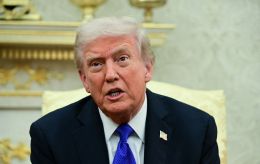Political analyst explains how Trump’s tariffs will impact Ukraine
 Illustrative photo: Ukraine may be the least affected by US President Donald Trump's tariff war (Getty Images)
Illustrative photo: Ukraine may be the least affected by US President Donald Trump's tariff war (Getty Images)
During the tariff war initiated by US President Donald Trump, Ukraine could be the least affected, as the base tariff rate of 10% has been imposed, stated political analyst Oleh Saakyan in a commentary to the RBC-Ukraine YouTube channel.
"We will be the least affected. The 10% is the base rate applied. This means that the general level of the water has risen for everyone equally, and we are on the same terms as others, with our producers not in worse conditions. And if we look at several other countries, it turns out that we are in a better position. The countries that had better conditions than Ukraine now have worse ones," said the political analyst.
He pointed out that the European Union was hit with a 20% tariff, which is significant because, for example, Hungary faces a 20% tariff while Ukraine only faces 10%. In this case, Ukrainian businesses are in a better position.
It is also interesting that Israel received a 17% tariff, despite having recently liberalized its tariffs with the US, hoping that they would not be affected by Trump’s decision. However, this did not happen, and Israel received a much higher rate, while most of Israel's neighbors, who are not strategic allies of the US, received the 10% rate.
"Interestingly, Trump is now hitting his own hardest. As the proverb says, 'Beat the dog before the lion.' He is acting purely according to the Russian principle. Poor Moldova received 31%. Why, nobody knows, it’s not like Moldova is a major threat to US financial stability. Although Trump positions it as if the 10% is for everyone by default, with increased tariffs for countries that have most unjustly treated the US," Saakyan noted.
He pointed out that the list includes several countries that also received such tariffs for unclear reasons. Meanwhile, the difference between Moldova and China is only 3%, as China received a 34% tariff.
"So, this whole situation will, of course, hit everyone, but it will hit us the least. Therefore, we could find ourselves, along with Turkey, the UK, and five or six other countries, in a situation with a 10% tariff in Europe among the US partners, excluding Asia and the Arab world, potentially facing competition in the movement of businesses and legal addresses," he explained.
This refers to a scenario where, for example, a company registered in Moldova would face a 31% tariff when exporting to the US, but if the same company were registered 50 kilometers to the north, say in the Odesa region or Chernivtsi, it would receive a 10% tariff.
"This could create a very interesting situation where we stand almost like free economic zones with a 10% tariff," said the political analyst.

